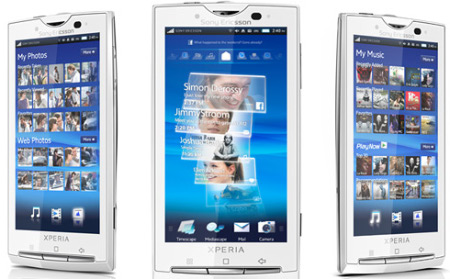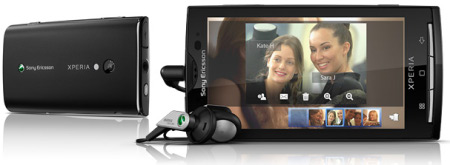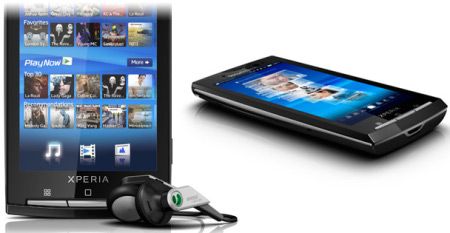Android phone sports 8.1-megapixel camera
Nov 3, 2009 — by Eric Brown — from the LinuxDevices Archive — 8 viewsSony Ericsson announced its first Android phone, along with a “UX” user interface targeting social networking. The Xperia X10 offers from 8 to 16GB of flash storage, a four-inch touchscreen, and an 8.1-megapixel camera with face recognition and geo-tagging, plus the usual 3G, WiFi, Bluetooth, and GPS features.
Basic specs and a photo of a Sony Ericsson "Xperia X3" Android phone appeared briefly on the Expansys retail site in July. The specs listed then still ring true today, revealing a high-end smartphone with a screen size (four inches) and camera resolution (8.1 megapixels) that appears to beat any Android phone announced to date.
The big screen boosts the phone's size to 4.7 x 2.5 x 0.5 inches, which could be a turn-off for some users, and it's a bit troubling that the company does not list estimated battery life. Still, the display should be a big plus for many, especially since no physical keyboard is offered.

Different views of the Xperia 10

Back and front of Xperia X10 in landscape mode
(Click to enlarge)
No carriers have yet been announced for the Xperia X10, but cellular network support includes GSM GPRS/EDGE as well as UMTS/HSPA. The phone also offers WiFi, Bluetooth, GPS, and a micro-USB connection, which is available for charging, synchronization, and file transfer, says the company.
Aside from its large screen and new UX applications (see farther below), the most notable feature of the X10 is its 8.1-megapixel autofocus camera. The camera offers 16x zoom, image stabilization, and video recording, says Sony Ericsson. Integrated software includes geo-tagging and face recognition (see farther below). Initially available in black and white, the phone is available with an optional "MW600" Bluetooth stereo headset, with FM radio and its own LED display.

Xperia X10 showing close-up of UI, and optional new FM-ready stereo headphones
(Click to enlarge)
- Memory — 1GB
- Flash — SanDisk microSD with 8GB standard; expandable up to 16GB
- Display — 4-inch, 854 x 480, 262,144 color TFT touchscreen
- Wireless communications:
- GSM GPRS/EDGE 850/900/1800/1900
- UMTS HSPA 900/1700/2100
- UMTS HSPA 800/850/1900/2100
- WiFi
- Bluetooth
- GPS (with geo-tagging support via camera)
- USB — Micro-USB connector
- Audio — 3.5mm audio jack; music player; optional Bluetooth stereo headset with FM Radio (MW600)
- Camera — 8.1-megapixel; 16x zoom; autofocus; face recognition; stabilizer; video recording
- Software (partial list):
- Google search, Maps, Calendar, Talk, Voice Search
- WebKit web browser
- Sony Ericsson Timescape (contacts)
- Sony Ericsson Mediascape (media playback)
- Email, Microsoft Exchange ActiveSync, MMS, SMS
- Wisepilot turn-by-turn navigation (free trial version)
- Productivity apps
- Dimensions — 4.7 x 2.5 x 0.5 inches (119 x 63 x 13mm)
- Weight — 4.8 oz (135 g)
- Operating system — Android with UX layer
UX layer takes on social networking, media sync
 According to Sony Ericsson, the Xperia 10 will be the first of many Android devices running on its new UX platform. UX (pictured at right) is said to build a UI layer on top of the "Open OS," the company's reference to the Linux-based Android operating system. The UX interface appears to be another take on integrating and syncing content from across different social networking sites and communications media, not unlike HTC's Sense UI provided with its Hero and Tattoo phones, or the MotoBlur interface offered with Motorola's Cliq.
According to Sony Ericsson, the Xperia 10 will be the first of many Android devices running on its new UX platform. UX (pictured at right) is said to build a UI layer on top of the "Open OS," the company's reference to the Linux-based Android operating system. The UX interface appears to be another take on integrating and syncing content from across different social networking sites and communications media, not unlike HTC's Sense UI provided with its Hero and Tattoo phones, or the MotoBlur interface offered with Motorola's Cliq.
The first two UX applications are Sony Ericsson Timescape, which offers a unified communications contact management interface, supporting conversations from Facebook, Twitter, and email, along with associated photo and text integration. Sony Ericsson Mediascape, meanwhile, is a multimedia playback app that integrates content from the phone, YouTube, PlayNow, and other sources, says the company.
Mediascape and Timescape are said to automatically recognize connections between contacts, content, and media. Pressing the phone's "infinite button," for example, aggregates all communications with a single person into one view. The applications also include intelligent face recognition for recognizing up to five faces in any picture and automatically connecting them with the "social phonebook" and other related communications interfaces.
In addition to new UX applications, the phone provides a variety of Google applications such as Google Maps and Google Talk, but it appears to lack the new Google Maps Navigation app offered with Verizon's Motorola-built, Android-based Droid phone. However, a free trial version of the Wisepilot turn-by-turn navigation app is offered, and users can download additional applications from the Android Market, says the company.
Stated Bert Nordberg, President, Sony Ericsson, "The Xperia X10 and the family of phones launching in the first half of 2010 underpin our commitment to an open and multi-platform strategy that maximises choice for the consumer and delivers the best possible consumer experience."
Stated Rikko Sakaguchi, EVP and Chief Creation Officer, Sony Ericsson, "With the X10, we are raising the bar we have set ourselves with entertainment-rich phones like Aino and Satio by making communication more fun and playful, multiplying and enriching opportunities to connect."
Availability
The Xperia X10 will be available in selected markets in Q1 2010, says Sony Ericsson, and additional Android/UX products will roll out "across the world including Japan from the first half of 2010," says the company. More information on the Xperia X10 may be found here.
An eWEEK story on the X10 should be here, and the aforementioned CNET story should be here.
This article was originally published on LinuxDevices.com and has been donated to the open source community by QuinStreet Inc. Please visit LinuxToday.com for up-to-date news and articles about Linux and open source.